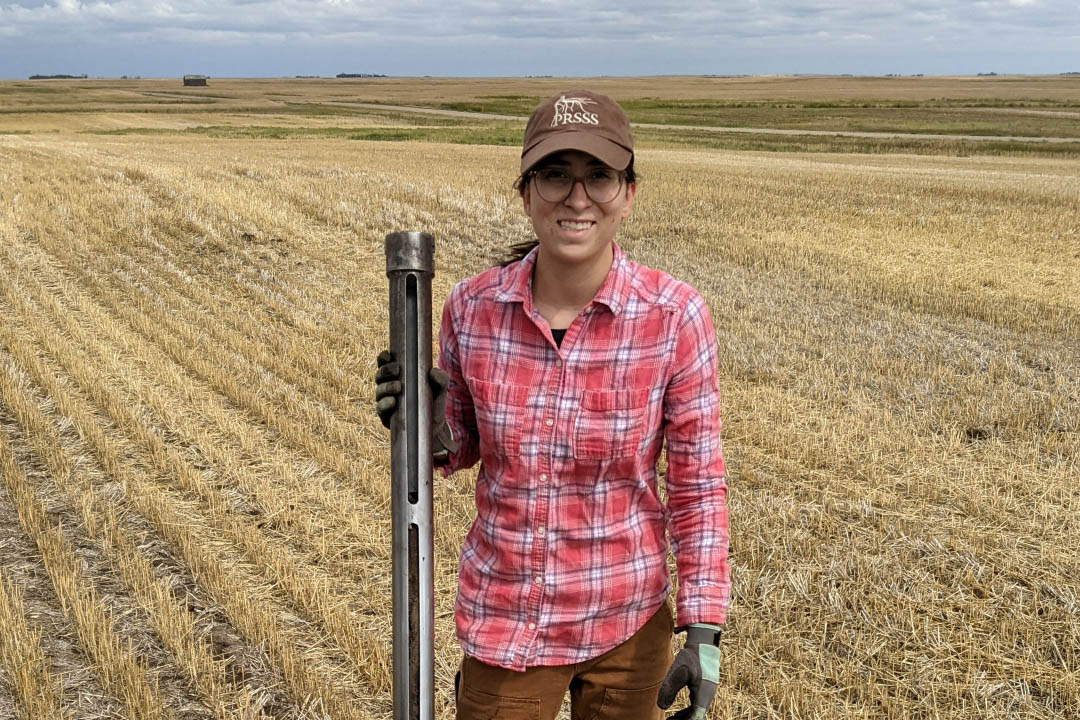
Measuring the amount of carbon in Saskatchewan wetland soils: USask study
University of Saskatchewan (USask) graduate student Chantel Chizen is investigating how much carbon is stored in the soil of Prairie wetlands, and what this can mean for environmental carbon management in agriculture.
By Brooke Kleiboer
Saskatchewan is home to 11 per cent of Canada’s wetlands, with an estimated 1.5 million wetland areas located in agricultural fields. The wetland regions analyzed in Chizen’s project are referred to as “pothole” wetlands, a category including sloughs or depressions in the ground filled with water.
“Together, healthy soil and freshwater are like the environmental cornerstone of food production,” said Chizen, who is a PhD candidate in the USask College of Agriculture and Bioresources.
Chizen’s doctorate project measures the amount of carbon in the soil of cultivated wetland regions in Saskatchewan, and how the soil carbon level changes across soil zones and with differing amounts of water, salt and drainage.
This information is essential for farmers, as soil carbon content contributes to the overall quality and functional ability of the soil to retain water and nutrients and to grow plants.
“We know that the brown soil zone (arid regions in Saskatchewan) will have less carbon than the black soil zone (moist regions in Saskatchewan), but we currently don’t have reliable values for how much carbon is stored in the soil of different pothole wetlands.”
Chizen and her research team collect soil samples during the fall following harvest from three different points in the wetland area and classify them based on colour and the presence of mottles. Mottles resemble specks of rust and are indicators of prolonged water presence in the soil.
The samples are taken back to the USask laboratory to determine their carbon content and the characteristics of their organic matter, to help build an understanding of how carbon is stored in the soil.
“We can then group the wetlands based on soil zones, how long the wetland is filled with water, and soil salinity, and compare the carbon values among these groups to see if the soil carbon is related to these factors or to other soil properties like nitrogen or pH levels.”
Wetland soil from the Ag in Motion Discovery Farm has also been sampled following drainage procedures to determine how this management practice affects soil organic matter quantity and quality. Chizen said the quality of the organic matter in drained wetlands may serve as an early indicator of soil carbon changes that may be occurring over longer than the study period of three years.
Sample collection will continue in fall 2022 so the team can reach its goal of collecting samples from 180 wetlands.
The project is supervised by soil science professor Dr. Angela Bedard-Haughn (PhD), who also serves as the dean of the USask College of Agriculture and Bioresources.
Chizen said that although the study focuses on Saskatchewan, the data can be applied to larger-scale studies of soil carbon and wetland ecosystem services across the Prairie Pothole Region, which extends through the Canadian Prairie provinces and the Upper Midwest of the United States.
The study is unique in that it considers soil samples from as deep as one metre, whereas most studies conducted in the past have only taken samples to a depth of 30 centimetres. In wetlands, deeper soil can contain a large quantity of stable carbon, so sampling to greater depth will provide more accurate soil carbon estimates.
The preliminary study results will be presented at the Soils and Crop Conference in March 2022, as well as at both the Canadian and American Society of Soil Science annual meetings.
“Knowing the amount of carbon in the Prairie potholes will play a key role in developing best management practices for wetland management and environmental carbon management in agricultural landscapes,” said Chizen.
The research is jointly funded by Canada’s Natural Sciences and Engineering Research Council (NSERC) Alliance grant program, the Saskatchewan Water Security Agency, the Saskatchewan Ministry of Agriculture’s Agriculture Development Fund, and the Saskatchewan Wheat Development Commission. Chizen has been awarded an NSERC Postgraduate Scholarship and was selected for the Foundation for Food and Agriculture Research’s Rockey FFAR Fellows Program.
This article first ran as part of the 2022 Young Innovators series, an initiative of the USask Research Profile and Impact office in partnership with the Saskatoon StarPhoenix.
Article re-posted on .
View original article.

